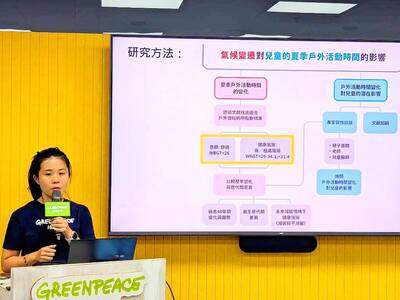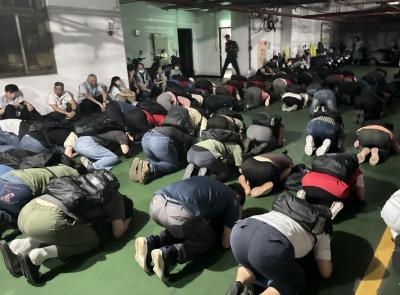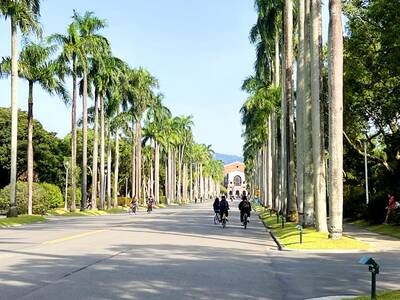The Environmental Protection Administration (EPA) on Tuesday approved a strategic environmental assessment (SEA) on offshore wind energy development, in a major step toward developing renewable energy sources.
The government pledged to increase the ratio of renewable power generation to 20 percent of total electricity generation by 2025 to replace nuclear power, and wind power is expected to make up about 40 percent of renewable energy production.
To expedite wind energy development, the Bureau of Energy requires potential wind farm developers to acquire environmental approval by 2017, while an SEA on national wind energy development is needed as a basis for reviewing individual development projects.
The SEA review on Tuesday was aimed at establishing such a basis and clearing the path for commercial-scale wind farms. The SEA committee has earmarked 36 sites with large offshore wind power potential.
Most sites are off the coasts of central Taiwan, and 60 percent are on waters off Changhua County, the habitat of the critically endangered Chinese white dolphin.
The impact of wind farms on the white dolphin population and fishery resources was a main topic of discussion for the review.
There are only about 60 white dolphins near Taiwan and they can be generally found in water no deeper than 15m off the coasts between Miaoli County and Tainan, so it would be advisable to construct wind farms in deep water far offshore, the Forestry Bureau said.
“There are few studies of white dolphins, and government authorities have said they do not know how white dolphins might be affected by noise. The sound of wind turbines and construction noise might drive the dolphins away and threaten their survival,” Taiwan West Coast Conservation Association member Wu Hui-chun (吳惠君) said.
According to a study on marine mammal behavior by German scientists, they could be driven away by noise transmitted from as far as 80km, Wu said.
The committee decided that offshore wind turbines could not be constructed within 500m of white dolphin habitats, and construction noise must be kept below 180 decibel, while construction must be suspended if white dolphins are discovered near construction sites.
Offshore wind farms cannot be constructed near wetlands or ecologically sensitive areas either.
Meanwhile, Changhua County Environmental Protection Union secretary-general Shih Yueh-ying (施月英) said Changhua and Yunlin counties have been known for their rich fishing resources, but the government has ignored the industry for the sake of wind power development.
Developers could allow fishermen to become shareholders in wind farms to share profits so there would be less resistance to development, Taiwan Environmental Protection Union secretary-general Chen Bing-heng (陳秉亨) said.
The offshore wind power case is the first SEA approved development since the Democratic Progressive Party administration was sworn in in May.

The government should improve children’s outdoor spaces and accelerate carbon reduction programs, as the risk of heat-related injury due to high summer temperatures rises each year, Greenpeace told a news conference yesterday. Greenpeace examined summer temperatures in Taipei, New Taipei City, Taoyuan, Hsinchu City, Taichung, Tainan and Kaohsiung to determine the effects of high temperatures and climate change on children’s outdoor activities, citing data garnered by China Medical University, which defines a wet-bulb globe temperature (WBGT) of 29°C or higher as posing the risk of heat-related injury. According to the Central Weather Administration, WBGT, commonly referred to as the heat index, estimates

Taipei and other northern cities are to host air-raid drills from 1:30pm to 2pm tomorrow as part of urban resilience drills held alongside the Han Kuang exercises, Taiwan’s largest annual military exercises. Taipei, New Taipei City, Keelung, Taoyuan, Yilan County, Hsinchu City and Hsinchu County are to hold the annual Wanan air defense exercise tomorrow, following similar drills held in central and southern Taiwan yesterday and today respectively. The Taipei Mass Rapid Transit (MRT) and Maokong Gondola are to run as usual, although stations and passenger parking lots would have an “entry only, no exit” policy once air raid sirens sound, Taipei

Taipei placed 14th in the Quacquarelli Symonds (QS) Best Student Cities 2026 list, its highest ever, according to results released yesterday. With an overall score of 89.1, the city climbed 12 places from the previous year, surpassing its previous best ranking of 17th in 2019. Taipei is “one of Asia’s leading higher-education hubs,” with strong employer activity scores and students “enjoying their experience of the city and often keen to stay after graduation,” a QS staff writer said. In addition to Taipei, Hsinchu (71st), Tainan (92nd), Taichung (113th) and Taoyuan (130th) also made QS’ list of the top 150 student cities. Hsinchu showed the

Environmental groups yesterday filed an appeal with the Executive Yuan, seeking to revoke the environmental impact assessment (EIA) conditionally approved in February for the Hsieh-ho Power Plant’s planned fourth liquefied natural gas (LNG) receiving station off the coast of Keelung. The appeal was filed jointly by the Protect Waimushan Seashore Action Group, the Wild at Heart Legal Defense Association and the Keelung City Taiwan Head Cultural Association, which together held a news conference outside the Executive Yuan in Taipei. Explaining the reasons for the appeal, Wang Hsing-chih (王醒之) of the Protect Waimushan Seashore Action Group said that the EIA failed to address